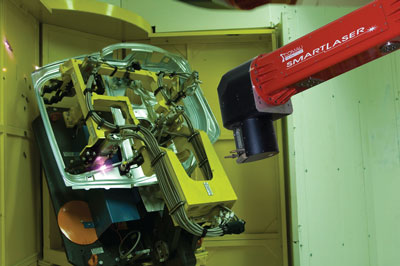WMG Pioneers Remote Fibre Laser Welding
As car manufacturers seek to cut the emissions and fuel consumption of vehicles all avenues have to be reviewed for potential improvement. The New Automotive Innovation & Growth Team roadmap report for the Department for Business, Innovation and Skills has described the future direction, concentrating upon Hybrid and Fuel Cell development to meet future European Fleet Average CO2 targets.
The target will not be met by addressing the power units alone; a more holistic approach has to be taken, reviewing opportunities from aerodynamics and rolling resistance, through to basic driveline technology and lightweight design.
 Programmes at WMG have been supporting the development of Lightweight Vehicle Technologies, reviewing the introduction of new grades of aluminium and high strength steel materials within the vehicle structure. The Carbon rating of vehicles is now of critical importance and the assembly process cannot be excluded from this evaluation indefinitely. Evaluation of any new process needs to assess power consumption and environmental impact, as it may not be long before the legislation on CO2 emissions will take into account the manufacturing process. One of the emergent technologies we have been developing with industrial partners is Remote Fibre Laser Welding (RFLW) and the benefits that can bring.
Programmes at WMG have been supporting the development of Lightweight Vehicle Technologies, reviewing the introduction of new grades of aluminium and high strength steel materials within the vehicle structure. The Carbon rating of vehicles is now of critical importance and the assembly process cannot be excluded from this evaluation indefinitely. Evaluation of any new process needs to assess power consumption and environmental impact, as it may not be long before the legislation on CO2 emissions will take into account the manufacturing process. One of the emergent technologies we have been developing with industrial partners is Remote Fibre Laser Welding (RFLW) and the benefits that can bring.
The application of RFLW for the joining of automotive structures can now be seriously considered as an alternative to the traditional joining processes of resistance spot welding (steel) and self pierce riveting (aluminium).
The opportunities anticipated from the application of RFLW when compared to resistance spot welding or self pierce riveting (SPR) are: faster processing speed, single sided access, comparable investment costs, improved piece cost, reduced floor space, improved energy utilisation, flexible manufacturing and product design. These benefits have now been confirmed within the business model developed by the project partners and a robust evaluation of these claims has been made.
The most significant cost item per joint for SPR is that of process consumables, predominantly the cost of the rivet itself. Rivets will also contribute roughly 4 kg to the overall weight of the vehicle, as well as requiring additional processing activities at the end of the vehicle life. An analysis of the cost model has shown that the variable having the greatest effect on the final figure is the level of facility utilisation.
Although the installation cost of a cell for remote laser welding is comparable to that for competing manufacturing processes the inherent flexibility of the process brings significant savings in the reuse of equipment for follow on or concurrent production of parts. Remote fibre laser welding has been found to produce joints of comparable quasi-static strength to those produced by existing joining processes.
A number of manufacturers, including Fiat, VW, BMW, Audi, Renault, Toyota and Mercedes have installed remote welding systems for steel assemblies. These systems are largely the result of internal developments with equipment suppliers, as few system integrators currently support this development. However, with the reduced costs per Watt from higher power lasers, this situation is changing.
The Remote Fibre Laser Welding Programme, funded by the UK Technology Strategy Board and based at WMG, has aimed to answer the challenges of utilising this fast, flexible process, and to benchmark remote laser welding against existing turnkey systems suitable for manufacturer and 1st tier supplier implementation. This programme has created a knowledge base from which a successful facility can now be implemented within the UK.
For more information on Remote Fibre Laser Welding, or any of the issues discussed, please find our contact details here...
